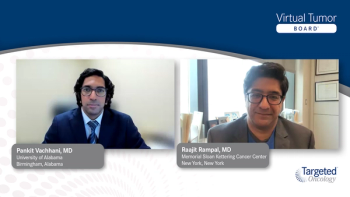
Novel Treatment Strategies in Endometrial Cancer
Closing out their program on endometrial carcinoma management, key opinion leaders highlight key novel therapeutic strategies in the evolving treatment landscape.
Episodes in this series

Transcript:
Robert L. Coleman, MD, FACOG, FACS:What’s exciting about this space is that with the biomarkers we’re starting to produce in the overall expression of endometrial cancer, particularly in the uterine serous, we have drugs that are better at targeting HER2 [human epidermal growth factor receptor 2]—particularly the amplified case—in patients who have immunohistochemistry expression. We have the whole class of these targeted antibody-drug conjugates, and that’s moving forward. Michael, with respect to endocrine therapy, we probably wouldn’t use that in an uterine serous tumor, but let’s talk about endometrial cancer in general. With endocrine therapy, we talked a little about single-agent hormones, but what else can we adopt from the breast cancer [treatment] world that might help us improve hormonal therapy?
Michael J. Birrer, MD, PhD: That’s a great question. We can’t forget the value of hormonal therapy in endometrial cancer. It’s been usurped a little in the sense that the well-differentiated tumors, the low-grade tumors, are also the ones that have defects in mismatch repair. The I/O [immuno-oncology] drugs [supplant] that, but we can’t forget about hormones. From a breast cancer standpoint, we have a number of hormonal agents way beyond tamoxifen [Soltamox]. Some of them are much more effective, like Faslodex [fulvestrant]. There are combinations of those agents with mTOR inhibitors and others that are worthy of looking at in this setting. They’re not going to be easy trials because it’s getting to be very busy, but we’re going to need to do at least single-arm phase 2s to see if we can get better activity.
Robert L. Coleman, MD, FACOG, FACS: The other pathways, like PI3 kinase pathway, have a lot of interest. There are cyclin kinase inhibitors, CDK4/6 inhibitors. A lot of these are good strategies to think about. Ultimately, in a grade 1 recurrent limited state, maybe we could get away with not having to do chemotherapy. That would be nice. Krish, before SGO [Society of Gynecologic Oncology Annual Meeting on Women’s Cancer], there was a lot of interest in changing the standard of care in the frontline setting with chemotherapy. What do we know so far about these new approaches?
Krishnansu S. Tewari, MD: There are 2 very large phase 3 randomized trials adding checkpoint [inhibitors] to carboplatin [Paraplatin]–paclitaxel [Abraxane] in the first-line setting, whether [patients are] newly diagnosed with measurable disease or recurrent but not previously treated with chemotherapy. Both studies met their primary end point, which was PFS [progression-free survival]. They were presented back-to-back at our meeting in Tampa [Florida]. We learned about the different eligibility criteria. The news release for NRG-GY018 suggested a benefit in not only mismatched repair–deficient patients but also mismatched repair–proficient patients, which is very exciting. We have to look at eligibility to see if there are differences. Maybe 1 study was selected for a more favorable prognostic group. The NRG-GY018 was chemotherapy plus pembrolizumab [Keytruda] vs placebo, and the RUBY study is chemotherapy plus dostarlimab [Jemperli]. They’re both phase 3 randomized studies, which is exciting and potentially practice changing. They’ll shake up the recurrence space.
Robert L. Coleman, MD, FACOG, FACS: Absolutely. The trial opens up all kinds of new therapeutic paradigms. We’re going to talk about prior exposure to I/O therapy and whether we have appropriate therapy, but we also have patients who progress on I/O therapy. How is that going to be managed? We talked about with patients getting lenvatinib [Lenvima] and pembrolizumab postchemotherapy. Many of those patients will have been previously exposed. It will take time, but an increasing proportion of patients will have had prior I/O therapy. Mike, what about replacing chemotherapy altogether? Do we have an opportunity to get rid of chemotherapy?
Michael J. Birrer, MD, PhD: That’s coming, or at least the trial is evolving. It makes a lot of sense. That would really be in the defective MMR [mismatch repair] group. The responses are so dramatic, and a lot of us feel that some of these patients are cured. That would be a logical choice to avoid chemotherapy altogether, and it would be terrific for our patients.
Robert L. Coleman, MD, FACOG, FACS: That’s for sure. Kimberly, when you see a patient who’s going to come to the office and say, “I heard something on TV,” or, “Dr Tewari said this is changing the standard of care. What should I do?” How are you going to approach that? That’s a tough education component: 2 trials, both positive. They’re going to want to know what’s best, and you’ve got all these choices. It’s going to get confusing. How are you going to break it down for them? I’m sure you can do it much better than we can.
Kimberly Halla, MSN, FNP-C: It’s a great time to be in this space because we have choices. There’s going to be a medication for every patient. Looking at adverse effect profiles for each patient, looking at patients specifically and knowing you have choices—it’s fantastic. I can’t wait to be a part of that.
Robert L. Coleman, MD, FACOG, FACS: I have to admit that I’m super excited about the opportunity. We’re investigating the use of these immune-based therapies and adjuvant therapy in not only advanced-stage patients but also early stage disease. We’re trying to get this immune education that would prevent recurrence as long term, even in patients who are curable. It’s exciting, and we’re excited to have all this new data to go off. Mike?
Michael J. Birrer, MD, PhD: We’ve come a long way from doxorubicin [Lipodox].
Robert L. Coleman, MD, FACOG, FACS: Exactly. We didn’t talk about it, but in the TP53 wild type, many of these patients are also the dMMR [deficient MMR] patient population. We have drugs focused on the compliancy of that protein, looking at ways to improve that with these selective inhibitors of nuclear export. We have new drugs coming down with MDM2 inhibitors. We have some cool stuff coming. I’m happy that in individual cancer, we have something to expand upon. It’s a huge win for our patients.
Before I close, I want to thank all the patients who’ve been generous with their participation in the clinical trials…and the investigators who’ve committed to change the standard of care and move the ball down the road. I want to thank this esteemed panel, which has made this fun to do. I appreciate your wisdom and insight on these 3 cases. I’m hopeful that in the future, we’ll get another opportunity to do this. For our viewing audience, thank you for joining us for our Targeted Oncology™ Virtual Tumor Board® presentation. We hope the discussion was a valuable use of your time and that you acquired practical knowledge that will help you in your clinical practice. Thank you all for joining me. Have a great day.
Transcript edited for clarity.













































